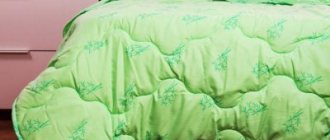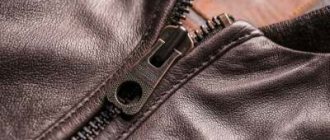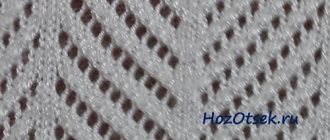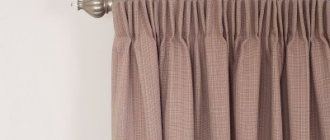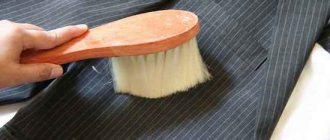Knitted items are relevant at all times. They are delicate, soft to the touch and warm during the cold season. But during wear, clothes become dirty and require regular cleaning. Knitted items should be washed taking into account their characteristics. After all, any incorrect actions can lead to deformation of the fibers. As a result, the clothes will be damaged and unsuitable for further use.
Knitted items require delicate washing
Is it possible?
You can wash knitted items either in a machine or by hand. However, there are a few points you need to pay attention to before you begin the procedure:
Determine the type of yarn. For natural wool, liquid detergents are used. They are washed using a special program. Synthetic knits can be processed as usual using powder.- Before you start washing, you need to read the information on the product label.
- Dosage the detergent according to the instructions, since a lot of foam is formed when washing knitted items.
- Wash items only when necessary. The less often knitted items come into contact with water, the better.
If you just need to refresh the fabric, resort to dry cleaning. The product is placed in a plastic bag, covered with soda and shaken thoroughly. After 15 minutes, all that remains is to shake and ventilate the item.
A few important secrets
If you need to wash something with a high collar, first tie a strong, durable thread around the edge of the neckline, and then remove it after washing. It is this trick that will allow you to avoid stretching the edge of the collar and losing its original shape.
It is recommended to first soak very dirty items for 15 minutes in a detergent solution (with a double dose), and then wash them normally (by hand). Lipstick marks can be removed using regular alcohol. You can soak the stain several times until it disappears. After this, the product is sent for washing or simply hung out for airing.
How do you like the article?
Selecting a detergent
Knitted items should be washed in liquid detergent. Such compositions effectively remove contaminants even in cold water.
Unlike powder, they quickly dissolve and are easy to rinse, do not linger in the fibers of the fabric and do not damage the product.
There are many specialized products that are designed to care exclusively for knitted items. These include:
Gel Laska wool and silk . The price is about 400 rubles for 3 liters. The product works at a temperature of 30-40 degrees.- Balm Nordland for wool and silk . Its cost is 340 rubles per 0.75 liter. The product is suitable for both hand and machine wash.
- Help washing liquid . The cost of 1 liter is 120 rubles.
If powder is used, then preference should be given to such compositions as:
- Villi (60 rubles),
- Cashmere (90 rubles),
- Luxus Professional (400 rubles).
You can purchase any detergent in a retail store, in the household chemicals department, or order it online.
Washing instructions
Knitted items need to be washed taking into account a number of factors. It is necessary to properly prepare them for the upcoming procedure, carefully squeeze the fabric from the water. Both hand and machine washing have their own nuances.
In the typewriter
A serious problem that all owners of knitted items face is pilling.
To prevent their formation, items should only be washed inside out. You can protect them from excess friction using a special washing mesh.
Procedure for machine washing knitted items:
Clean the product from dust and other debris that may get caught in the hinges.- Fasten buttons and zippers, check pockets.
- Turn the item inside out and place it in a laundry bag.
- Set the machine to “Wool” or “Delicate Wash” mode. If there is no such program, then the setting is carried out manually: water temperature - 30 degrees, spin speed no higher than 600 rpm. It is recommended to turn on the “extra rinse” function.
- Pour or pour the selected detergent into the washing machine compartment.
- Wait for the cycle to complete, take out the item, turn it right side out and leave to dry.
If synthetic fibers predominate in the fabric, then the water temperature can be increased to 40 degrees. To prevent the long neckline, cuffs or other delicate parts from stretching during the washing process, they are secured with thick thread. Remove it after the product has dried slightly.
How to do it manually?
Hand washing is considered a more gentle way to care for knitted items. A person has the opportunity to minimize the time they spend in water, as well as control the friction force at each stage.
Procedure:
- Fill the basin with water. Its temperature should not be higher than 30-40 degrees.
- Dissolve the detergent until a rich foam forms. For items made from natural wool, you can use hair shampoo.
- Turn the item inside out.
- Immerse the product in water. Soaking is necessary when there are difficult stains on the fabric.
- After half an hour, gently rub the item with your hands. Effort should be minimal. Only stains are treated in this way.
- Rinse the item thoroughly, changing the water several times.
- For the final rinse, you can add a little hair conditioner to the bowl.
After washing, the product is not wrung out or twisted. It is simply left in the bathroom until most of the water has drained. You can wrap it in a dry towel, it will absorb excess moisture.
When putting a knitted product away for storage after washing, it is not wrapped in plastic. Wool must breathe. She will lock herself in the bag and fall off.
We wash blankets and blankets made from yarn
Blankets and bedspreads knitted from yarn are very popular. They give the interior a special mood
It is important to know how to properly wash such products
- The water should be at medium temperature. It is enough to use water at 40 degrees.
- Use mild detergents, preferably in liquid form.
- Dry flat.
In the modern world, many wardrobe and interior items are made of yarn, so you need to know the rules for caring for them. Let your clothes and yarn products always look beautiful, give you softness and comfort!
Today, manufacturers offer a huge selection of textiles and yarn patterns. Knitting an original, beautiful thing will not be difficult, the main thing is desire. In addition, do not forget that the quality of the yarn affects the practicality and wearability of the product. Keep in mind that you will be knitting clothes or an accessory for a long time, so the product should wash well, without losing color and its original performance qualities.
As you know, yarn must be washed before knitting. Of course, there are no clear opinions on this matter; some, on the contrary, immediately move on to the work process. You should definitely wash yarn that is already a little stale. In this case, it will straighten out and its elasticity will return. In addition, after washing you will understand how threads can fade and shrink.
Most needlewomen believe, on the contrary, that washing is just a waste of time. In their opinion, you can understand the capabilities and characteristics of yarn by knitting a small piece, which can then be washed.
Of course, it’s entirely up to you whether to wash the yarn or not. On the other hand, it’s better not to risk it and wash at least the section you knitted in advance to check the condition of the material.
Woolen threads should be washed to check their shedding and how the product may shrink. The yarn is rewound into a skein, the diameter of which should not be more than 35 cm. You can use a chair or a wide pan. The uniform is tied strictly in four places, and then carefully removed.
When washing, it is not necessary to use powder; you can use laundry soap. You can use chemicals, but without any additives. Villi, weasel and other means are suitable.
Prepare a soap solution. To do this, take 10 grams of soap and dilute it in 1 liter of water. It can be planed or grated. The soapy water must be thoroughly shaken. The resulting solution is poured into a bowl of cool water. Washing is done in water with one temperature regime; temperature changes should not be allowed, otherwise the threads will become matted.
Rinse the yarn in clean water gently, whisking with your hands. The pasma can be rinsed in water with lemon juice or vinegar.
The yarn is wrung out gently, lightly, no need to twist it. Afterwards, it must be hung over a basin or bathtub so that all the water is removed from it. The yarn is dried indoors, drafts and radiators should be avoided. Do not use household appliances during drying to speed up the process. The whole process takes no more than two hours if we are talking about a small piece of fabric.
How to wash a handmade product?
Hand knitted items must be handled with care as they are particularly susceptible to pilling . To prevent the appearance of stray hairs, you should give the tissues a rest from the body. As a rule, within a day the fibers restore their natural elasticity.
To prevent the fabric from becoming rough, temperature changes should not be allowed. It is not recommended to wash it in warm water; it is better to rinse it in cold water.
Features of care:
- preference is given to manual processing;
- use only liquid detergents;
- if the wash is the first, use a minimal amount of gel;
- the fabric is not twisted or wrung out;
- If the product is washed in a machine, then set the gentle mode and turn off the spin cycle.
When washing for the first time, you can add a little vinegar to the water. It will make the colors brighter.
Rules for preparing knitted items for wear
In order for a newly knitted item to last longer and bring joy to its owner, it should also be processed before use. Moreover, it is recommended to do the processing itself even before all the parts are sewn. Parts of the product are soaked in a soapy solution and mixed a little with rubbing, but without friction. After this, everything is rinsed and dried. Only after this can the item be sewn. To prevent the material itself from shrinking, the water should be warm, not hot (about 30 degrees).
Drying rules
Knitted items need to be dried correctly. The appearance they will have after washing depends on this.
While they are wet, they are not twisted or squeezed. It is not recommended to lift items soaked in water so that the openwork parts do not stretch under their own weight.
The larger the knitting and the wider the loops, the higher the risk of deformation of the fabric. You need to remove things from the bathtub after the water stops flowing from them in streams.
Dry clothes on a flat surface. A cloth is placed under it that absorbs water well. Most often a terry towel is used. It needs to be changed when it gets wet.
Rules to follow:
- Having laid out the item on the dryer, you need to straighten out all the folds;
- do not hang the product on a rope;
- do not expose the yarn to direct sunlight;
- Do not dry the product near heat sources or on heating appliances.
If the fabric has stretched after washing, it is gently compressed in the desired direction. A shrunken product, on the contrary, is slightly stretched. The tighter the loops fit together, the longer the wool will take to dry.
Ironing Features
Typically, woolen products are not ironed, and ironing is recommended in very extreme cases. If the manufacturer provides ironing, it should be done this way:
- iron the item only when it is completely dry;
- Turn the product inside out before ironing;
- you can use slightly damp gauze, this will help avoid shine;
- the iron should slide without pressure, gently and without pulling the material;
- The ironing temperature should be observed; modern models of irons are equipped with functions such as “woolen items”, which sets the device to a certain suitable temperature. If the iron does not have such modes, you should look at the hint on the label of the item you need to iron.
If you lay out your sweater correctly while still drying, you will most likely not have to iron it.
How to iron?
If, after drying and ironing, creases and wrinkled areas appear on the item, you can iron it. Rules to follow:
- Products made from pure wool should not be ironed, even on the reverse side. They can only be steamed through thick gauze. The steam generator must be kept at a distance of 10 cm.
- Mixed fabrics are ironed with the steam function turned on.
- To avoid damaging the product, always turn it inside out and use gauze.
- If ironing is to be done, there is no need to wait for the fabric fibers to dry completely.
Knitted items are very sensitive to high temperatures. Therefore, they are ironed at minimum power.
If a scorch suddenly appears on the fabric, you can make it less noticeable by wiping the area with a cloth soaked in hydrogen peroxide and ammonia. The components are taken in equal quantities.
Storage
- Knitted clothes should be stored clean and perfectly dried for long-term storage.
- Fold carefully and store in piles.
- Be sure to use anti-parasite products based on natural ingredients: lavender, cedar or tobacco.
- Clothes made of linen and cotton thread, made without sleeves, can be hung on hangers.
- The pellets that appear over time are carefully removed with a special brush.
- Possible ties after use are carefully pulled out using a hook or needle on the inside out and secured.
- It is best to keep down products in linen bags.
At first it seems that caring for knitted items made from natural and synthetic materials is very difficult. But actually it is not. You just have to try it once, and you will no longer be intimidated by the peculiarities of washing, drying and storage. And the reward will be the perfect appearance of your clothes, which will delight you for many years.
Useful tips
Tips that all owners of knitted items should familiarize themselves with:
You can improve the quality of your wash using fabric softener.- Knitted items can be washed with other items, but they must match each other in color.
- When loading knitted items into the drum of a washing machine, take into account their weight. After getting wet, they become 3-4 times heavier.
- If the product has absorbed foreign odors, it is not necessary to resort to washing. It is enough to ventilate it in the fresh air for 12 hours.
- For washing light-colored fabrics, you can use gentle liquid stain removers and oxygen bleaches.
To fluff up small fluff that has rolled up after washing, you need to lay the dry product on a flat surface and go over it with a fine-toothed comb. If it gets stuck on the spools, there is no need to pull it. They are carefully cut with scissors or a special machine.


